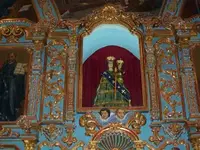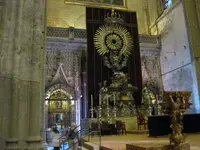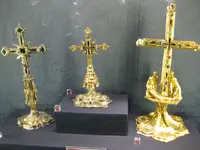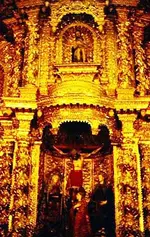Oroblanco
Gold Member
- Joined
- Jan 21, 2005
- Messages
- 7,841
- Reaction score
- 9,876
- Golden Thread
- 0
- Location
- DAKOTA TERRITORY
- Detector(s) used
- Tesoro Lobo Supertraq, (95%) Garrett Scorpion (5%)
Long winded post - extra coffee alert
Hola amigos,
This reply got very long (again) so I must beg your indulgence, or feel free to skip ahead and I won't be offended. Thank you in advance.
Cactusjumper (Joe) you did not answer my question about the properties of the Indians. I had asked it because I think you already knew the answer, which is within this quote
I put several sentences in bold, but one point I wish to especially emphasize is that the Indians were not allowed to own property! NO mines, except in rare instances as when the Jesuits were trying to lure runaway Indians to return to the missions, as we posted some time ago. And I must respectfully disagree about the Indians having mines, for even father Kino mentioned that the Pimas had silver mines of their own, which they were willing to mine silver to "buy" themselves a padre. However on the establishment of a Mission, ALL of the Indians property became property of the Jesuits, including the mines. In a very real sense, these early Missions were the model for Communism, with everything owned by the ruling class which in this case were a priestly Order.
The reasons for why the Jesuits were expelled from Spanish dominions we can never know, for the king of Spain never published them. In fact his <king Charles III> order only states,
The Jesuits had been implicated in recent political agitations, and this is PROBABLY the primary reason, and everything else was secondary. The actual mines themselves, owned by the Jesuits openly or illicitly, were hardly on the top of the Spanish list, however the Spanish royal authorities KNEW that the Jesuits had accumulated wealth and this is why such determined efforts were made to find the concealed treasures, which were almost without success. Not entirely without success however as one cache of GOLD dust was in fact found in a Jesuit mission in "poor" Baja California.
Baja California is a topic worth its own thread, for the main item of profit in the peninsula was PEARLS not mines, though some mines were operated, and later found to be hardly worth working. A padre with unlimited slave labor at his disposal however could operate such mines at a profit. Spanish authorities were puzzled that so much moneys had been donated, so many special favors in laws, taxes etc had been granted to the Jesuits in Baja and yet they found the people of Baja practically destitute. Yet even this is full of contradictions - for example the mission church in Loreto (Baja) is quite beautiful, and the interior remains impressive to this day:

Not everyone whom toured Baja on the departure of the Jesuits got the impression that it had been such a poverty-stricken wilderness either;
Even the pearl fishing done by the people for themselves, paid off for the Jesuits, quote
I keep repeating this but the Jesuits OWNED MINES (plural) and in most cases assigned the ownership to their colleges, which are in turn owned by the Order. These mines produced SILVER and gold and copper, yet very little of this has ever been accounted for. The Jesuits were hardly the only Order of priests involved in mining, even some of the female Sisterhoods had a hand in it. This is why the Spanish royal decree forbidding religious Orders from mining does not specifically name the Jesuits, for nearly all were involved to some degree. These official orders from the crown had almost no effect.
There is evidence that the Jesuits were secretly negotiating with the English and Dutch to betray virtually the whole of Spanish America to them; <most to the Dutch, however a key island in South America off Chile was going to be betrayed to the English> this is reported by English authors of the time, and word of this almost certainly reached the Spanish crown. Whether these reports were true or not (it is possible that these stories were put into circulation to discredit the Jesuits) any Spanish monarch would have been alarmed to hear of it.
Springfield I am very jealous of you now!
Good luck and good hunting to you all, I hope you find the treasures that you seek.
Oroblanco
Hola amigos,
This reply got very long (again) so I must beg your indulgence, or feel free to skip ahead and I won't be offended. Thank you in advance.
Cactusjumper (Joe) you did not answer my question about the properties of the Indians. I had asked it because I think you already knew the answer, which is within this quote
<The Works of Bancroft, Vol 1, pp 487 footnote>It has been stated {Lasaepas Baja Col 167} that Galvez admired the Jesuit management but in a letter to Lasuen {Arch StaB MS i 22} he alludes to certain scandalous evils caused by the Jesuits and the fact that he restored the temporalities to the Franciscans only proves that he regarded the original system as less injurious to the country than the rascality of the comisionados In a proclamation of Nov 23 1768 { Id i 17 20} he expresses his surprise and disappointment at the state of affairs. After all the laws made and moneys granted he expected to find thriving settlements but finds instead mere haciendas de campo or farms with houses for padres soldiers and servants only The natives go naked, have been withdrawn from the seashore where they lived by fishmg and are forced to wander in the mountains living on roots and berries often obliged to work without recompense Hence they look with dislike upon agriculture and regard civilization as the greatest evil Missions with fertile lands need laborers while many rancherias are collected in sterile spots No Indian is permitted to own property The system has reduced the population to 7,149 souls.
I put several sentences in bold, but one point I wish to especially emphasize is that the Indians were not allowed to own property! NO mines, except in rare instances as when the Jesuits were trying to lure runaway Indians to return to the missions, as we posted some time ago. And I must respectfully disagree about the Indians having mines, for even father Kino mentioned that the Pimas had silver mines of their own, which they were willing to mine silver to "buy" themselves a padre. However on the establishment of a Mission, ALL of the Indians property became property of the Jesuits, including the mines. In a very real sense, these early Missions were the model for Communism, with everything owned by the ruling class which in this case were a priestly Order.
The reasons for why the Jesuits were expelled from Spanish dominions we can never know, for the king of Spain never published them. In fact his <king Charles III> order only states,
Having accepted the opinion of the members of my Royal Council in Extraordinary, which met on the 29th of last January for consultation concerning past occurrences and concerning matters which persons of the highest character have reported to me; moved by very grave causes relative to the obligation under which I find myself placed of maintaining my people in subordination, tranquility, and justice, and other urgent, just, and necessary reasons, which I reserve in my royal mind; making use of the supreme economical authority, which the Almighty has placed in my hands for the protection of my vassals, and the respect of my crown; I have ordered that the Jesuits be expelled from all my dominions of Spain, the Indies, and Philippine Islands, and other adjacent regions, priests as well as coadjutors or lay-brothers, who may have made the first profession, and the novices, who may wish to follow them; and that all the properties of the Society in my dominions be taken;
The Jesuits had been implicated in recent political agitations, and this is PROBABLY the primary reason, and everything else was secondary. The actual mines themselves, owned by the Jesuits openly or illicitly, were hardly on the top of the Spanish list, however the Spanish royal authorities KNEW that the Jesuits had accumulated wealth and this is why such determined efforts were made to find the concealed treasures, which were almost without success. Not entirely without success however as one cache of GOLD dust was in fact found in a Jesuit mission in "poor" Baja California.
Baja California is a topic worth its own thread, for the main item of profit in the peninsula was PEARLS not mines, though some mines were operated, and later found to be hardly worth working. A padre with unlimited slave labor at his disposal however could operate such mines at a profit. Spanish authorities were puzzled that so much moneys had been donated, so many special favors in laws, taxes etc had been granted to the Jesuits in Baja and yet they found the people of Baja practically destitute. Yet even this is full of contradictions - for example the mission church in Loreto (Baja) is quite beautiful, and the interior remains impressive to this day:

Not everyone whom toured Baja on the departure of the Jesuits got the impression that it had been such a poverty-stricken wilderness either;
<The Founding of Spanish California, pp 85-86>route Moreover it is certain that at this time Baja California was believed to be very rich in precious metals an opinion prevailing that the Jesuits had wilfully concealed the fact. We may therefore pay some attention to Galvez's activities in the peninsula. As regards its supposed wealth we may note a memorial by officials of the Real Caja of Guadalajara October 8 1765 which stated that there were two mines in Baja California and might be more if quicksilver for extracting ores could be had and if persons of expert mining knowledge might be sent there. The land was worth being developed. Gold mines were being discovered, pearls were found in many places the soil was fertile and there were great numbers of cattle. Yet the inhabitants were for the most part Indians. Eight years before in 1757 they had made the same suggestions to Viceroy Amarillas but got no reply. 69 On February 25 1766 Arriaga forwarded this memorial to the Council of the Indies 60 Croix's letters to his brother show that reports of this character were believed. In a letter of December 29 1768 he remarked that the Californias which had always passed for a sterile country would be able from 1769 on to maintain themselves without costing the king a sou. Judge what a profit the Jesuits must have had he said, and yet they had drawn a subsidy from the king for many years on the pretext of the land's sterility. 61 Again January 25 1769 he mentioned Galvez's work in the peninsula saying how pleased the king would be with that province because of its pearls, gold, and silver, a wealth which the Jesuits had in great part concealed 62
Even the pearl fishing done by the people for themselves, paid off for the Jesuits, quote
< The book of the pearl: the history, art, science, and industry, By George Frederick Kunz, Charles Hugh Stevenson, pp 251>In the eighteenth century the Notre Dame de Loreto possessed a remarkable collection of Mexican pearls which had been presented from time to time by the fishermen During the regime of the Jesuits it was customary to devote the proceeds of the last day of the fishery to the decoration of the altar of that mission After the expulsion of this religious order in 1767 the mission was pillaged and the collection dissipated
I keep repeating this but the Jesuits OWNED MINES (plural) and in most cases assigned the ownership to their colleges, which are in turn owned by the Order. These mines produced SILVER and gold and copper, yet very little of this has ever been accounted for. The Jesuits were hardly the only Order of priests involved in mining, even some of the female Sisterhoods had a hand in it. This is why the Spanish royal decree forbidding religious Orders from mining does not specifically name the Jesuits, for nearly all were involved to some degree. These official orders from the crown had almost no effect.
There is evidence that the Jesuits were secretly negotiating with the English and Dutch to betray virtually the whole of Spanish America to them; <most to the Dutch, however a key island in South America off Chile was going to be betrayed to the English> this is reported by English authors of the time, and word of this almost certainly reached the Spanish crown. Whether these reports were true or not (it is possible that these stories were put into circulation to discredit the Jesuits) any Spanish monarch would have been alarmed to hear of it.
Springfield I am very jealous of you now!
Good luck and good hunting to you all, I hope you find the treasures that you seek.
Oroblanco











